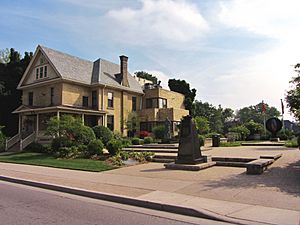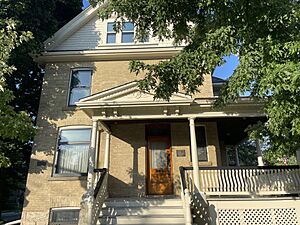Banting House facts for kids

Banting House in 2013
|
|
| Location | 442 Adelaide Street North London, Ontario N6B 3H8 |
|---|---|
| Official name: National Historic Site of Canada | |
| Designated: | 1997 |
| Type: | Municipal Heritage Designation (Part IV) |
| Designated: | August 2, 1983 |
Banting House is a museum in London, Ontario, Canada. You can find it at 442 Adelaide Street North. It's famous as the "Birthplace of Insulin." This is where Sir Frederick Banting had a brilliant idea on October 31, 1920. This idea led to the amazing discovery of insulin.
Since 1984, the house has been a museum. It teaches visitors all about Banting's discovery and his life. The London & District Branch of the Canadian Diabetes Association also has offices here. For many people affected by diabetes, this house is very special. It reminds them of Banting's scientific work that saved their lives or the lives of their loved ones.
Contents
The Story of Banting House
How Banting's Idea Changed Medicine
Frederick Banting lived in this house in London for ten months, starting in June 1920. He tried to open his own medical practice. When it didn't do well, he started working at the University of Western Ontario. While preparing for a lecture there, he got his famous idea. This idea, just 25 words long, was the key to discovering insulin. Insulin helped prevent the certain death of people with diabetes. Banting then went to the University of Toronto in the spring of 1921 to start his research.
What You Can See at the Museum
Banting House tells the story behind the discovery of insulin. It also shares details about Banting's life and career. The museum has different rooms, called galleries. These galleries show everything from his time in London to his work in both World Wars. You can also see his efforts as an artist. Some important items include Banting's original art, his desk, and his bed frame. You can also see his Military Cross, the KBE medal, and a copy of his Nobel Prize.
Banting House was named a National Historic Site of Canada in 1997. This means it's a very important place in Canadian history.
History of the Museum
For many years, people saw the house as the "Birthplace of Insulin." Many wanted it to become a special place to honor this Canadian hero. The Detroit Free Press first called it the "Birthplace of Insulin" in 1923.
After 47 years, the house received official recognition in 1970. The London Public Library Board placed a special plaque on the house. In 1981, the London & District Branch of the Canadian Diabetes Association bought the house. They used it as an office. Their goal was to fix up the house and turn it into a museum. With help from grants and fundraising, the museum opened in 1984.
Exploring the Museum's Features

Banting House has many old papers, items, and other things connected to Banting. These show his role as a co-discoverer of insulin, a doctor, and an artist. They also show his involvement in the First and Second World Wars.
Inside the Galleries
One gallery shows what Banting's office might have looked like. It has some of his personal items. These include his original medicine cabinet. There's also a special glass cylinder Banting used at the University of Western Ontario. The next room is an apothecary, like an old pharmacy. It has a sink that Banting put in for his medical practice.
Other parts of the museum also hold Banting's original belongings. His desk and bed frame are especially notable. The bed frame is in Banting's bedroom. Visitors can stand near it or take a picture. It's not blocked off like some other museum displays.
Special Displays and Medals
You can also see an official copy of the Nobel Prize medal. This medal was given to Banting and Macleod. Many of Banting's other medals are also on display. Another area is the military gallery. It shows what an operating room might have looked like during the First World War, where Banting worked. There's also information about projects he led during the Second World War. A whole gallery is filled with artwork created by Banting himself.
Sir Frederick G. Banting Square
Next to the museum is Sir Frederick G. Banting Square. This is a garden with information plaques. It has three main attractions. Two of these, a statue of Banting writing his important idea and the Flame of Hope, were revealed by Queen Elizabeth The Queen Mother. The Flame of Hope was lit by the Queen Mother during her visit. It stands for the hope that one day there will be a cure for diabetes.
The third attraction is a globe sculpture. It was added more recently in 2010. This globe shows Canada's gift to the world. It welcomes visitors from other countries. The names of every country are listed on it.
See also
 In Spanish: Casa Banting para niños
In Spanish: Casa Banting para niños



